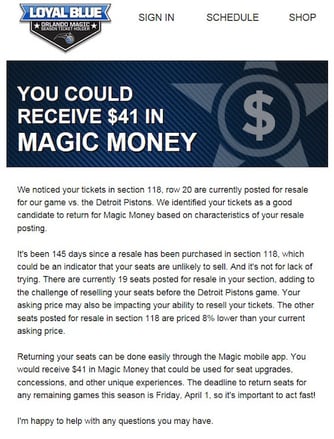What if you could write thousands of stories, personalized for individual prospects or customers, in just seconds? It sounds like magic, but it’s really just artificial intelligence. And thanks to Automated Insights (@AInsights), companies like the Associated Press (AP) and the Orlando Magic generate countless pieces of content from their data thousands of times faster than a human.
For instance, the AP uses Automated Insights’ Wordsmith solution to automatically write earnings reports from data, freeing up reporters for higher value tasks. The Magic  generate personalized emails to spur fan engagement. Other customers use the technology to automate internal reports, compose product descriptions and create online content that attracts, nurtures and converts prospects.
generate personalized emails to spur fan engagement. Other customers use the technology to automate internal reports, compose product descriptions and create online content that attracts, nurtures and converts prospects.
We spoke with Automated Insights director of product management Adam Long (@Adam_B_Long) about how the company uses natural language generation (NLG) and natural language processing (NLP) to augment content creation through machines.
In a single sentence or statement, describe Automated Insights.
Automated Insights is the creator of Wordsmith, a software platform lets you create sophisticated templates that turn raw data into unique pieces of writing about that data.
How does the company use artificial intelligence (i.e. machine learning, natural language generation, natural language processing, deep learning, etc.)?
Wordsmith is a natural language generation (NLG) platform. That’s an academic way of saying it lets anyone build out their own artificial intelligence to automate their writing. For example, an investment bank could automate commentary on customers’ portfolios. For the first time, that bank could explain changes in the portfolio in understandable prose, as though an expert was personally explaining it to each customer, every day.
To do this, Wordsmith users build out rules-based templates that explain to Wordsmith what to focus on and how to describe different scenarios. For example, you might create a rule so that Wordsmith describes a temperature over 80 degrees Fahrenheit as “hot.” From there, you can teach Wordsmith different ways to say “hot” (and different ways of writing the whole sentence about how hot it is).
The final templates become very sophisticated. So sophisticated, in fact, that academic studies have shown that readers cannot distinguish the content from a Wordsmith user’s template from articles written manually by journalists.
There are elements of natural language processing (NLP) in Wordsmith as well. For example, the software can parse a sentence for you and suggest what parts of it you may want to build rules around.
See The Marketer’s Guide to Artificial Intelligence Terminology to learn more about natural language generation.
.png?width=679&height=265&name=blog-seo-variationbreakout-020716%20(1).png)
What do you see as the limitations of artificial intelligence as it exists today?
On a practical level, artificial intelligence is limited only by the availability of data. Because there’s a direct relationship between the richness of data and the capability of an artificial intelligence application, data becomes the key to an AI system.
We’re finding ourselves at the interesting intersection of privacy and convenience, and of utility and commercialization. As people become more accustomed to benefitting from the data that underpins everyday life—from scheduling meetings to managing health outcomes—artificial intelligence will be limited only by what we have the incentive to create with it.
What do you see as the future potential of artificial intelligence in marketing?
Marketing is an ideal environment for artificial intelligence. Wordsmith is already showing how humans can build out AI systems to help with marketing. For example, we have a version of Wordsmith that automatically analyzes Google Analytics, Adwords, and Facebook data and then writes a weekly summary of how your marketing is doing. We’re already at the point where Wordsmith can go beyond descriptions of what happened and into prescriptions for how to fix it and predictions on what will happen next.
For more outbound purposes, artificial intelligence like Wordsmith is being used to create product descriptions for ecommerce firms and property listings for real estate agencies. These firms are able to replace expensive freelancers (who have questionable quality) with high-quality, automated content. It’s so cost-effective, their in-house marketers can use Wordsmith templates to write more descriptions than they could afford to with freelancers.
Finally, Wordsmith is being used by marketers to generate personalized, persuasive messages to their audiences. For example, the Orlando Magic uses Wordsmith to send custom messages to each season ticket holder based on tickets they want to resell and their preferences for fan experiences. When you can speak directly to each user, based on their interests, your conversion rate goes way up.
What makes Wordsmith different than competing or traditional solutions?

The great thing about Wordsmith is that it’s the world’s first in several categories. Wordsmith received the first patent for natural language generation software. It is the first platform to create a billion articles in a single year (and is closing in on two billion!). And, most importantly, it’s the only NLG platform that you can actually sign up for and try out yourself.
Like a lot of emerging technology markets, the existing NLG options are consulting services. You go to a company, spend hundreds of thousands of dollars, wait three months for them to build a template, and eventually you see some content come out the other end. Wordsmith is way different: you build the template yourself. You control every word. And you see output in a matter of a few hours.
Who are the prototype customers in terms of company size and industries?
Companies of all sizes use Wordsmith, from startups to Fortune 100. The Associated Press is using Wordsmith to produce company earnings stories and Minor League Baseball game recaps. The Orlando Magic uses Wordsmith to generate personalized emails that include special offers unique to each fan.
Wordsmith content is being generated in multiple languages as well. Smart home company digitalSTROM is using Wordsmith to generate energy usage reports in German that inform homeowners about their energy usage every day. Because Wordsmith is designed to be used for just about any natural language generation use case a person can imagine, in any language, it’s being used by people in more than 50 industries to produce more than 1.5 billion stories a year.
What are the primary use cases of your product(s) for marketers?
Wordsmith is being used to generate client reports, product descriptions, campaign summaries, TV programming announcements, ratings analysis, online content for clients, social media updates and many other types of personalized content.
One of the interesting patterns in Wordsmith usage among our customers is that they’re automating the creation of content that couldn’t otherwise exist. In other words, they’re not automating work they already produce; they’re creating entirely new types of content that simply aren’t possible without Wordsmith. For example, Edmunds.com generates descriptions for the millions of cars on their site. These descriptions are so specific that they can even compare the car you’re looking at to other cars listed close by. No marketing team is big enough to do that much content without using Wordsmith.
Any other thoughts on AI in marketing, or advice for marketers who are just starting to explore the possibilities of AI?
My advice is to start with an AI tool that is designed to be user-friendly. You want to find a technology that can start with data in a format you already have, like spreadsheets. And you want a friendly user interface that doesn’t require you to have programming skills to use.
Paul Roetzer
Paul Roetzer is founder and CEO of Marketing AI Institute. He is the author of Marketing Artificial Intelligence (Matt Holt Books, 2022) The Marketing Performance Blueprint (Wiley, 2014) and The Marketing Agency Blueprint (Wiley, 2012); and creator of the Marketing AI Conference (MAICON).



